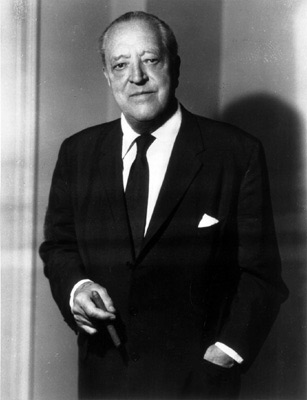
Ludwig Mies van der Rohe was a German-American architect, academic, and interior designer. He was commonly referred to as Mies, his surname. He is regarded as one of the pioneers of modern architecture.
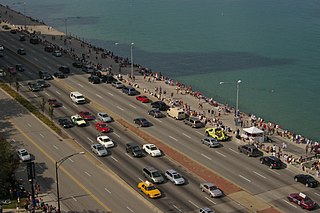
Lake Shore Drive is an expressway that runs alongside the shoreline of Lake Michigan, and adjacent to parkland and beaches, in Chicago. Except for the portion north of Foster Avenue, Lake Shore Drive is designated as part of U.S. Highway 41. A portion of the expressway on the Outer Drive Bridge and its bridge approaches is multilevel.

Streeterville is a neighborhood in the Near North Side community area of Chicago, Illinois, United States, north of the Chicago River. It is bounded by the river on the south, the Magnificent Mile portion of Michigan Avenue on the west, and Lake Michigan on the north and east, according to most sources, although the City of Chicago only recognizes a small portion of this region as Streeterville. Thus, it can be described as the Magnificent Mile plus all land east of it. The tourist attraction of Navy Pier and Ohio Street Beach extend out into the lake from southern Streeterville. To the north, the East Lake Shore Drive District, where the Drive curves around the shoreline, may be considered an extension the Gold Coast. The majority of the land in this neighborhood is reclaimed sandbar.

Water Tower Place is a large urban, mixed-use development comprising a 758,000 sq ft (70,400 m2) shopping mall in a 74-story skyscraper in Chicago, Illinois, United States. The mall is located at 835 North Michigan Avenue, along the Magnificent Mile. It is named after the nearby Chicago Water Tower, and is owned by affiliates of Brookfield Property Partners. As reported by the Chicago Suntimes, Brookfield Property Partners handed the keys to the project back to their lender, MetLife, owing to numerous retail vacancies following the closing of Macy's and the impact of COVID and increasing crime along the Magnificent Mile.

Edgewater is a lakefront community area on the North Side of the city of Chicago, Illinois six miles north of the Loop. The most recently established of the city's 77 official community areas, Edgewater is bounded by Foster Avenue on the south, Devon Avenue on the north, Ravenswood Avenue on the west, and Lake Michigan on the east. Edgewater contains several beaches for residents to enjoy. Chicago's largest park, Lincoln Park, stretches south from Edgewater for seven miles along the waterfront, almost to downtown. Until 1980, Edgewater was part of Uptown, and historically it constituted the northeastern corner of Lake View Township, an independent suburb annexed by the city of Chicago in 1889. Today, Uptown is to Edgewater's south, Lincoln Square to its west, West Ridge to its northwest and Rogers Park to its north.
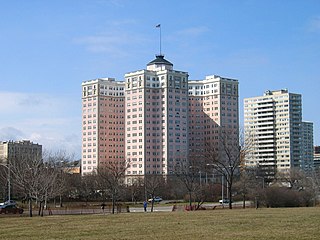
The Bryn Mawr Historic District is on the lakefront of the Edgewater neighborhood of far-north Chicago, Illinois. It extends along Bryn Mawr Avenue between Broadway and Sheridan Road. Its most prominent features are the Belle Shore Apartment Hotel, Bryn Mawr Apartment Hotel, Edgewater Beach Apartments, Edgewater Presbyterian Church, Manor House, and the northernmost area of Lincoln Park.
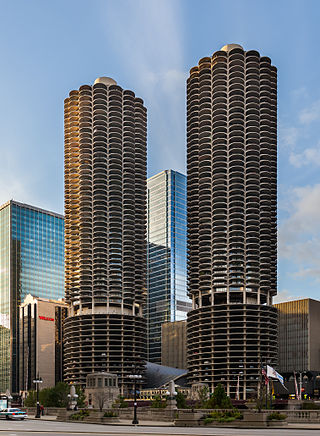
Marina City is a mixed-use residential-commercial building complex in Chicago, Illinois, United States, North America, designed by architect Bertrand Goldberg. The multi-building complex opened between 1963 and 1967 and occupies almost an entire city block on State Street on the north bank of the Chicago River on the Near North Side, directly across from the Loop. Portions of the complex were designated a Chicago Landmark in 2016. The towers' symbolic similarity to rural Illinois corncobs has often been noted in media.
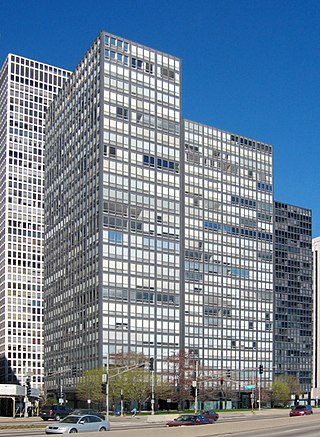
860–880 Lake Shore Drive is a twin pair of glass-and-steel apartment towers on N. Lake Shore Drive along Lake Michigan in the Streeterville neighborhood of Chicago, Illinois. Construction began in 1949 and the project was completed in 1951. The towers were added to the National Register of Historic Places on August 28, 1980, and were designated as Chicago Landmarks on June 10, 1996. The 26-floor, 254-ft tall towers were designed by the architect Ludwig Mies van der Rohe, and dubbed the "Glass House" apartments. Construction was by the Chicago real estate developer Herbert Greenwald, and the Sumner S. Sollitt Company. The design principles were copied extensively and are now considered characteristic of the modern International Style as well as essential for the development of modern high-tech architecture.
Alfred Samuel Alschuler was a Chicago architect.
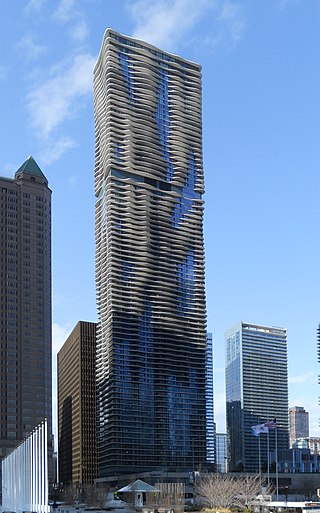
Aqua is an 82-story mixed-use skyscraper in Lakeshore East, downtown Chicago, Illinois. Designed by a team led by Jeanne Gang of Studio Gang Architects, with James Loewenberg of Loewenberg & Associates as the Architect of Record, it includes five levels of parking below ground. The building's eighty-story, 140,000 sq ft (13,000 m2) base is topped by a 82,550 sq ft (7,669 m2) terrace with gardens, gazebos, pools, hot tubs, a walking/running track and a fire pit. Each floor covers approximately 16,000 sq ft (1,500 m2).

Sheridan Road is a major north-south street that leads from Diversey Parkway in Chicago, Illinois, north to the Illinois-Wisconsin border and beyond to Racine. Throughout most of its run, it is the easternmost north-south through street, closest to Lake Michigan. From Chicago, it passes through Chicago's wealthy lakeside North Shore suburbs, and then Waukegan and Zion, until it reaches the Illinois-Wisconsin state line in Winthrop Harbor. In Wisconsin, the road leads north through Pleasant Prairie and Kenosha, until it ends on the south side of Racine, in Mount Pleasant.
Marshall and Fox was a United States architectural firm based in Chicago from 1905 to 1926. The principals, Benjamin H. Marshall and Charles E. Fox, designed a number of significant buildings of many types in Chicago and other cities, but they were best known for luxury hotels and apartment buildings.

Regents Park is a 1,026 unit, upscale apartment complex in the Indian Village section of the Kenwood community area of Chicago in Cook County, Illinois, United States, and adjacent to the Hyde Park community area border. Bordering Harold Washington Park, its two parallel towers are just west of Lake Shore Drive, Burnham Park and Lake Michigan with clear park and lake views to the east and south. The 37 floor Regents Park South Tower was completed in 1972 and the 36 floor Regents Park North Tower was completed in 1974. The South Tower is the tallest building in Kenwood, and overlooks Lake Michigan and Burnham Park to the east and Harold Washington Park to the south.

The Chicago Beach Hotel was a luxury resort hotel located at 1660 East Hyde Park Boulevard in the Indian Village neighborhood of the Kenwood community area of Chicago, Illinois.
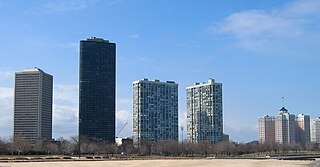
Park Tower is a lakefront high-rise residential building in the Edgewater community area in Chicago. It is one of the largest all-residential buildings in Chicago and the second-tallest building in Illinois outside of downtown Chicago.

The Edgewater in Madison, Wisconsin is a hotel which opened in 1948. It was listed on the National Register of Historic Places in 1997 as part of the Mansion Hill Historic District.



























